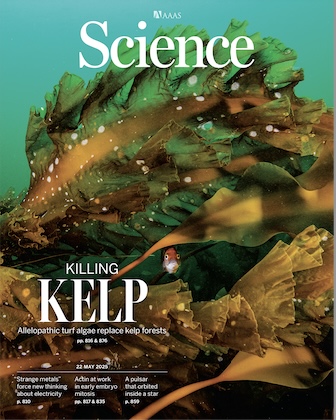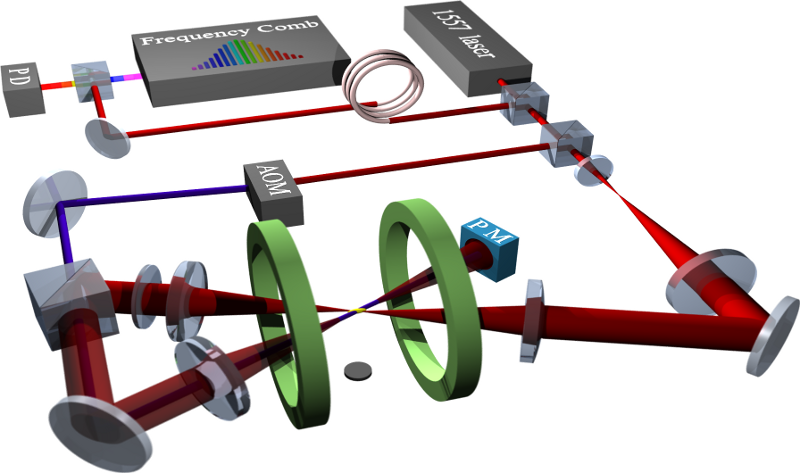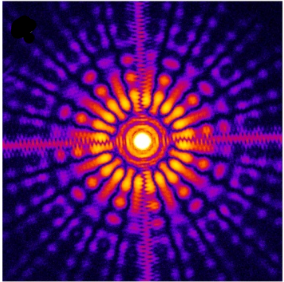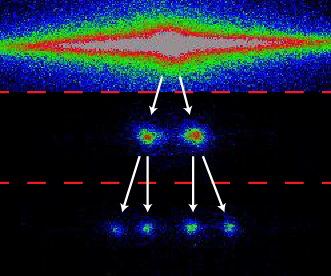Research / News
THIS WEBSITE WILL
BE REPLACED SOON BY ONE WHICH LOOKS MORE
MODERN
There are NEW (June
2025) PhD positions available, check it out
here.
Update June 2025:
New funding by NWO: ENW-M2 grant of 800kE for
"Helium (plus) as quantum probe for
fundamental physics - Q-PROBE"
Update May 2025:
Our Science paper on the best charge radius
difference determination of the helion and
alpha particle has been publish finally! This
is based on measuring the isotope shift in
ultracold quantum degenerate helium on the 2
3S - 2 1S transition at 1557 nm.

Y. van de Werf, K. Steinebach, R. Jannin,
H.L. Bethlem, K.S.E. Eikema,
Alpha and helion charge radius difference
determined from quantum degenerate helium,
Science 388, 850-853 (2025)
https://www.science.org/doi/10.1126/science.adj2462
Update December 2024:
Our paper on the first excitation of He+ (in a
beam) on the 1S-2S transition based on pulses
derived from a frequency comb laser has been
published. The transition is induced with a
two-photon transition by combining 790 nm and
the 25th harmonic of it at 32 nm (made with
High-Harmonic Generation). With this
experiment we demonstrate the feasibility of
our excitation method. We are now working
towards a precision measurement of the 1S-2S
transition by exciting trapped He+ ions with 2
phase-coherent pulses based on the Ramsey-comb
method developed in our lab.
E.L.
Grundeman, V. Barbe, Andres Martinez de
Velasco, C. Roth, M. Collombon, J.J. Krauth,
L.S. Dreissen, R. Taieb, K.S.E. Eikema
Laser excitation of the 1S-2S transition in
singly-ionized helium
Communications Physics 7, 414 (2024)
https://www.nature.com/articles/s42005-024-01891-4
Update February 2020:

The new ion trap for He+ 1S-2S spectroscopy
has been constructed (see above, wrapped in
foil for transport) with the generous help of
the group of Prof. Tanja Mehlstaeubler at PTB
Germany, and it is now in Amsterdam.
Update October 2019: our paper about the xenon
Ramsey-comb+HHG demonstration experiment
described below has been published in Phys.
Rev. Lett. 123, 143001 (2019)
With this demonstration one of our
main targets, precision spectroscopy of the 1S-2S
He+ transition for fundamental tests, has just
come a lot closer. In the experiment with xenon we
demonstrate that the Ramsey-comb spectroscopy
method which we will use for He+ works very well
with high-harmonic generation (HHG). HHG is
required to produce the wavelength for 1S-2S
excitation near ~30 nm. This is a vital step
towards He+ 1S-2S spectroscopy!
Older research funding:
A NWO/FOM Program grant of 1.8 MEuro
to investigate the
Proton Radius Puzzle using precision metrology in
several systems. This grant was awarded in December 2016 to
together with the colleagues of the QML group, and
prof. Eikema is the program leader.
A European
Research Council (ERC) Advanced Grant of 2.5
MEuro in
March 2016 for prof. Eikema to investigate QED
and the proton radius puzzle by precision
spectroscopy on the 1S-2S transition of trapped
helium+ ions.
and a Projectruimte
Grant from NWO (2018) obtained initially
by Wim Vassen.
|
  |
Research Themes / Experiments
The research of the Ultrafast
Laser Physics and Precision Metrology Group is based on
precision spectroscopy using frequency comb lasers and
ultrafast laser technology, to test fundamental physics.
The main projects of the group are listed below with a
short explanation.

|
Ramsey-Comb
Excitation - Precision Spectroscopy
for Fundamental Tests
We developed the
Ramsey-comb spectroscopy method to enable
precision spectroscopy of calculable
systems, such a singly-ionized helium or
molecular hydrogen, for fundamental
tests.
These systems have transitions in the
deep-UV, or even extreme ultraviolet, for
which no precision lasers exist. One can
make these wavelengths by nonlinear
upconversion in crystals and by
high-harmonic generation. We obtain the
required power for this by amplification
of two (ultrashort) frequency comb laser
pulses. Phase-coherent excitation based on
these pulses then enables to measure
transition frequencies of atoms and
molecules at short wavelengths with
unprecedented accuracy.
General
information on frequency comb lasers and
and the Ramsey-comb spectroscopy method
|
|
1S-2S Spectroscopy of
He+ Ions Trapped in a Paul Trap
Quantum
Electrodynamics (QED) is so far the best
tested and most successful theory within
the Standard Model. We want to improve
tests of QED (and e.g. determine the alpha
particle charge radius, or the Rydberg
constant) by a precision measurement of
the 1S-2S transition in singly-ionized
helium. By comparing the results with
measurements of muonic hydrogen and
'normal' electronic hydrogen, one can
search for new physics. We are currently
building up an experiment for this purpose
(funded by an ERC Advanced Grant) and we
will use the Ramsey-Comb Spectroscopy
method to excite the 1S-2S transition in
helium+ ions. The scheme requires 32 nm
light (extreme ultraviolet), which we
generate by high-harmonic generation of
amplified frequency comb laser pulses. The
initial target is a spectroscopic accuracy
of 12 decimal places (10 kHz), enabling a
several times improved test of QED, and
shed light on the 'proton-radius puzzle'.
Ultimately an accuracy approaching 15
decimal places might become possible!
We demonstrated
for the first time the combination of
high-harmonic generation and Ramsey-comb
spectroscopy in Xe, and recently we have
been able to excite the 1S-2S transition
in He+ made in a beam. These are
important milestone for the He+ project.
More
information on the helium-plus experiment
|

|
|

|
X-EF Spectroscopy of
Molecular Hydrogen
The theory of
the simplest neutral molecule, H2, is
improving so rapidly that it has become
very interesting to perform precision
spectroscopy to test QED and molecular
theory with it. The target is to measure
the ionization or dissociation energy, as
that can be calculated best. Our part in
it is the measurement of the X-EF
transition (X=ground state) using
Ramsey-comb spectroscopy in the deep-UV,
which we improved for ortho H2 by 100
times (Phys. Rev. Lett. 120, 043204
(2018)).
We are now working on measuring the same
transition for para-H2 and to a
measurement of the fundamental ground tone
(V=0 to V=1 energy difference).
More
information on the H2 experiment (under
construction)
|
|
2 3S - 2 1S
Spectroscopy of Quantum-Degenerate
Helium
This project
aims to perform high precision
spectroscopy on quantum degenerate helium
trapped in an optical dipole-trap, which
is then used to study quantum behavior of
the atoms in the trap, and for
measurements of the size of the nucleus of
the 4He and 3He atom (the alpha particle
resp. helion). We probe this with laser
spectroscopy on the 2 3S - 2 1S transition
at 1557 nm. To reach the highest accuracy,
the atoms are trapped at ultralow
temperatures in the focus of a laser beam
at a 'magic wavelength' of 320 nm. Helium
is then trapped either as a Bose
condensate (4He) or a degenerate Fermi gas
(3He). The challenge is to measure the
transition frequencies with an accuracy of
potentially 10 Hz (!), which corresponds
to a 13 decimal places at the transition
wavelength of 1557 nm. Recently (May 2025)
we published a Science paper (see the News
section above) demonstrating a record
accuracy of 170 Hz on the transition for
3He, leading to the most accurate charge
radius difference to date between the
helion and alpha particle!
This project was originated by Wim Vassen,
and is now continued in our group.
See here
for more information on the meta-stable
helium experiment
|
 |
|
 |
Soft X-ray
Generation and Lens-less Imaging
This project is
based on a collaboration with the group of
Stefan Witte at the ARCNL. The resolution
of imaging, such as microscopy, ultimately
depends on the wavelength that is used.
With shorter wavelengths one can resolve
smaller objects. We are developing methods
using 'lensless' imaging techniques
combined with high-harmonic generation of
soft-X-rays to explore the new
possibilities in this wavelength range.
One interesting property is that materials
become partly transparent at soft-X-rays,
enabling to look through materials.
The extreme
ultraviolet / soft-X-ray light is produced
via high-harmonic generation using
ultra-short laser pulses (<20 fs) at a
repetition rate of 300 Hz. The harmonic
generating process is rather inefficient,
but it leads to highly coherent X-rays. If
an object is illuminated with such a beam,
then clear diffraction patterns are
produced (see the picture) from which the
object can be reconstructed via iterative
procedures. The ultimate goad is 3D
imaging with element selectivity.
More
information at the ARCNL webpage of the
group of Stefan Witte
|
|
Direct Frequency Comb
Excitation and Coherent Control
In the past we
have performed full-reprate direct
frequency comb excitation for the first
time of trapped ions (Ca+) published in Phys.
Rev. Lett. 111, 023007 (2013), and
used coherent control to suppress the
background in two-photon direct frequency
comb spectroscopy (published in Nature
Photonics 7, 38-42 (2013)).
|

|
|
We gratefully acknowledge
financial support from the following organizations:
Questions? Contact: k.s.e.eikema@vu.nl
|
















